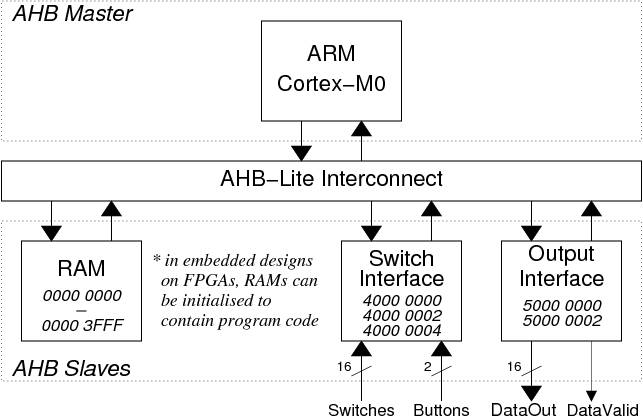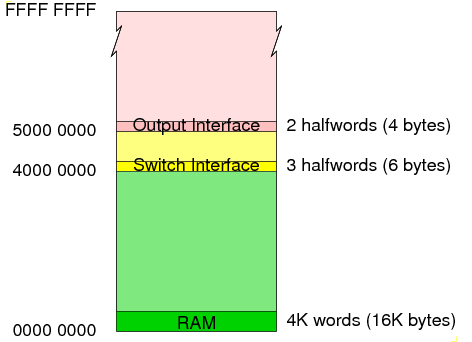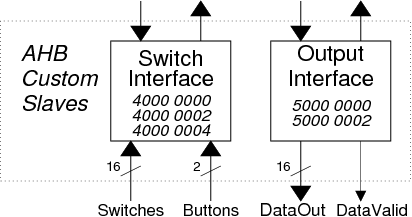Overview of a Simple ARM SoC
A very simple ARM System on Chip has been designed:

- RAM
16K bytes for program and data memory (including stack) - Switch Interface
Occupying three 16-bit memory locations - Output Interface
Occupying two 16-bit memory locations
Memory Map
-
The memory map is sparsely populated with the unused areas being filled with secondary images
of the real slave devices:

The secondary images are an artefact of the partial address decoding which only uses the top 4 address bits (HADDR[31:28]) in order to decide which slave is being accessed.
Files
In order to build the ARM SoC, we need SystemVerilog files to model the hardware plus 'C' program files and other support files to build the software. Further files are required to support simulation:
- Hardware
- Software
- C Program Code
- Support files
- Simulation
Operation of the custom interface modules
SoC design is a blend of hardware design and software design including third-party components such as microprocessor cores and library software and custom components such as custom interfaces and application software. When looking at the custom components, there is often a trade-off to be made between undertaking a particular task in hardware or software. Some tasks may be easily carried out in hardware leading to simplified software while other tasks may be more easily carried out in software leading to simplified hardware.
In this example we have two custom interface modules which have been designed to integrate with the external world (in this case just switches, buttons and LEDs) and simplify the software:

- Switch Interface
The switch interface (ahb_switches.sv) allows numbers to be entered via 16 switches and two buttons.
In order to enter a number, the user will set up the binary number on the switches and then press one of the buttons.
The aim of the interface is to avoid the processing of unwanted/false data - for example, changing the switch input from 3 to 4 may involve the following transitions:
0000 0000 0000 0011 (3) 0000 0000 0000 0111 (7) 0000 0000 0000 0101 (5) 0000 0000 0000 0100 (4)
including two unwanted/false data values (7 and 5).By introducing a button for number entry, we can ensure that only valid numbers are entered. By introducing a second button it allows us to enter two different 16 bit numbers using only 16 switches.
Based on this requirement, we might design an interface containing two registers:
- SwitchData[0] Register containing 16 bits from switches entered via Button[0]
- SwitchData[1] Register containing 16 bits from switches entered via Button[1]
In this case we would have no way to distinguish a series of numbers: 5,7,3 entered via Button[0] from a longer sequence including repeats: 5,7,7,7,3,3.
The more sophisticated approach used here includes a third register containing status information combined with a handshaking protocol which is typical of a lot of custom interface harware:
- When one of the buttons is pressed, the relevant SwitchData register is updated and the associated bit in the Status register goes to 1.
- When one of the SwitchData registers is accessed by the processor, the associated bit in the Status register goes to 0.
This allows the processor to see if there is new data available, simply by checking one of the bits in the Status register.
Note that this interface does not deal with switch bounce. If switch bounce is perceived to be a problem, we could include software which might ignore duplicate data entered in quick succession. Alternatively debouncing hardware could be added to the switch interface.
- Output Interface
The output interface (ahb_out.sv) allows data values and error status (data validity) information to be displayed via LEDs.
The aim of the interface is to ensure that the data and the data validity information is always in sync.
Based on this requirement, we might design an interface containing two registers:
- DataOut Register containing 16 bits of data
- DataValid Register containing a single data bit telling us whether the data is valid
With this simple approach we have a problem that, whichever register is updated first, we will have a few clock cycles where the DataValid value doesn't correspond to the DataOut value (e.g. if the DataOut register is updated first, there will be a few cycles when the old DataValid value and the new DataOut value exist together). While this is not a problem if the output is going to some LEDs it will often cause a problem if the output is driving some other circuit. For this reason this interface is designed such that DataOut and DataValid change on the same rising clock edge.
To support this operation, we will have two addressable registers (these are the registers that are visible to the programmer):
- DataOut Register containing 16 bits of data
- NextDataValid Register containing a single data bit telling us whether the next data is valid
and a third register which is not addressable:
- DataValid Register containing a single data bit telling us whether the data is valid
In order to output a data value, the programmer will write a bit to the NextDataValid register to specify the vailidity of the next data and then write the data itself to the DataOut register. The writing of the DataOut register will trigger a copy of the NextDataValid register to the DataValid register thus ensuring that the two outputs are always in sync:
DataOut <= HWDATA; DataValid <= NextDataValid;In common with many custom interface circuits, this interface also supports a Status register which allows the programmer to see the current status of both the DataValid and NextDataValid bits.
- Register Access Quirks
The memory-mapped registers in these custom interface circuits have a variety of features:
- Read/Write Registers
The DataOut register in the output interface can be read or written.
- Read-Only Registers
The SwitchData registers in the input interface can be read but not written. The same goes for the Status registers in either interface.
- Write-Only Registers
The NextDataValid register in the output interface can be written but not read.
- Register Access Side Effects
Writing to the DataOut register in the output interface has the side effect of changing the DataValid register and the Status register. Similarly reading from a SwitchData register in the input interface has the side effect of changing Status register.
When you design your own custom interface circuits you should think about the access requirements and access side effects for the memory-mapped registers.
- Read/Write Registers
Preparation
- Create a new directory for the lab (e.g. ~/design/system_on_chip/example_arm_altera)
and change to the new directory:
mkdir -p ~/design/system_on_chip/example_arm_altera cd ~/design/system_on_chip/example_arm_altera - Copy the design files (not including the Cortex-M0):
init_arm_soc_altera_example -here - Download the obfuscated Cortex-M0 file and place it in the behavioural subdirectory:
Compile C Program
- In the software sub-directory, the
makefile and the
soc.ld linker script
are used to compile the main C language file:
main.c,
and the support files:
vectors_designstart.c and
crt.c.
Running the appropriate make commands in the software directory:
cd software make clean make code.hexshould create a Verilog hex format file named "code.hex" which can be used in simulation and FPGA synthesis. - Open the "code.hex" file in a text editor to check that it has been created.
- Run an additional make command to create a dissassembly listing of the program:
make code.lstExamining the "code.lst" file in a text editor can be very helpful when trying to debug a system-on-chip design in simulation.Note that you can generate "code.hex" and "code.lst" files at the same time using the following make command:
make all
Simulate ARM SoC
- In the main directory (~/design/system_on_chip/example), a
simulate script exists to
simplify the task of running the simulation:
cd .. ./simulate &(The xmverilog command to run the simulation is:
xmverilog +gui +access+r \ +tcl+testbench/soc.tcl \ -y behavioural +libext+.sv \ +define+prog_file=software/code.hex \ testbench/soc_stim.svbut it's easier to use the simulate script) - Consult the HADDR and HSEL_... signals in the waveform window and satisfy yourself that the correct active HSEL_... signal is being selected based on any particular address value. (Identify at least one address for each of the HSEL_... signals and confirm that it is in the correct range)
- Look at the Console output and the main.c program. Can you explain the sequence of "DataOut" values that you see in simulator console?
Synthesis
In order to synthesise the system onto an FPGA development board you will need a top level "wrapper" file and a matching constraints file:
| FPGA Vendor | wrapper file | constraints file | |
|---|---|---|---|
| DE0 | Altera (Intel) | de0_wrapper.sv | DE0.qsf |
| DE1-SoC | Altera (Intel) | de1_soc_wrapper.sv | DE1_SoC.qsf |
| DE2 | Altera (Intel) | de2_wrapper.sv | DE2.qsf |
| DE2-115 | Altera (Intel) | de2_wrapper.sv | DE2-115.qsf |
Iain McNally
28-1-2025